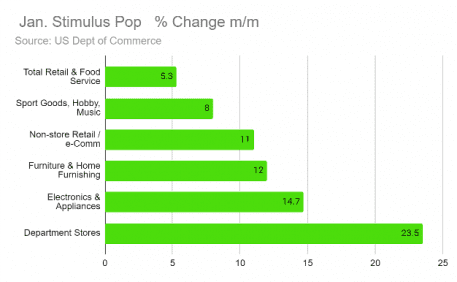Retailers Will Be Major Beneficiaries Of Third Stimulus Check And Extended Unemployment Benefits

As the third federal stimulus package works its way through Congress and closer to President Biden’s desk, retailers and industry trade groups are poised to see a spike in consumer spending thanks to a spate of $1,400 checks that could go out by the end of the month.
Although last-minute negotiations and revisions are still possible, the Senate’s passage of a slightly more restrictive version of the $1.9 trillion package all but sealed the deal for the bill to become law.
Even with the tighter caps and collars, White House Press Secretary Jen Psaki said direct payments will go to 158.5 million households, or 98 percent of the people who received $600 payments in December.
 Given that the third round of checks is more than double those issued three months ago, the economic impact is expected to be even more significant than the last round, which snapped a three-month slump in consumption and led to a huge spike in January retail sales.
Given that the third round of checks is more than double those issued three months ago, the economic impact is expected to be even more significant than the last round, which snapped a three-month slump in consumption and led to a huge spike in January retail sales.
Although every category measured by the Commerce Department posted gains for the month, five key areas clearly benefited the most from a near instantaneous flow-through of spending.
Compared to the overall 5.3 percent increase in Retail and Food Service for January, Sporting Goods, Hobby and Music rose 8 percent; “non-retail” sales or eCommerce jumped 11 percent; Furniture and Home Furnishings snapped 12 percent higher, Electronics and Appliances leaped almost 15 percent and Department Stores outpaced all categories with a 23.5 percent gain.
More Than Just $1,400 Checks
While the fate and size of individual checks garner the most attention and scrutiny, it is important to note that they only account for about 20 percent of the total $1.9 trillion outlay. Another big chunk of money will go to extending the $300 per week (about $1,200 per month) unemployment benefit for some 19 million people still out of work.
In both cases, though, the federal disbursements will be promptly spent and ultimately settle into the bank accounts of landlords, utilities, auto repairs, personal care services, grocery stores and of course to both brick-and-mortar and online retailers.
In mid-February, Walmart CFO Brett Biggs told investors the company’s fourth quarter sales were partly “supported by stimulus spending.”
“Even if conditions stay generally similar to now, for any length of time this year and with limited additional stimulus, we would expect continued solid underlying performance from Walmart U.S. with low-single-digit comps and continued solid eCommerce sales growth,” Biggs said.
Last week, Burlington Stores CEO Michael O’Sullivan was clear about the impact the $600 checks had on his quarter.
“We know that the federal stimulus checks helped us in January and conversely, we also know that the unseasonably warm weather really hurt us in November,” he said.
At the same time, Ross Stores also acknowledged the stimulus effect last week when reporting its fourth quarter results, especially on the company’s lower price point dd’s brand stores.
“I think history would say whether it’s tax refunds or stimulus — the dd’s customer is more sensitive to stimulus payments and frankly tax refunds. So we would expect to see a more immediate impact in the dd’s business,” Ross Stores President and Chief Operating Officer Michael J. Hartshorn said on the company’s earnings call.
52 Million Jobs
In calling for prompt passage of the bill, the National Retail Federation released a statement that was more focused on the need to streamline vaccines than on the benefit of one-time payments.
“Ensuring that the American people are given the opportunity to quickly and safely get vaccinated against COVID-19 is the most critical component of the legislation passed today by the Senate,” NRF President and CEO Matthew Shay said. “The retail industry has been front and center throughout this crisis and remains engaged by providing vaccines to employees and consumers in communities they serve across the country.”
According to the NRF, retail is the nation’s largest private-sector employer, supporting one in four U.S. jobs, providing a paycheck for 52 million people while contributing $3.9 trillion to annual GDP.
